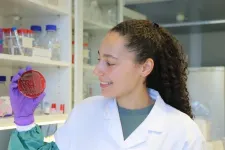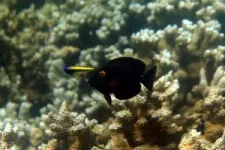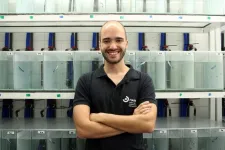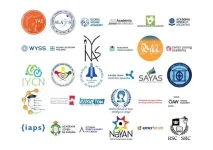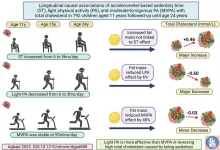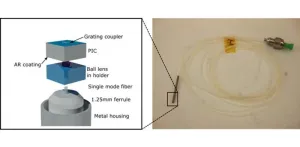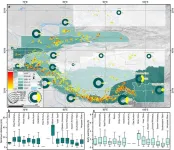(Press-News.org) “Antimicrobial resistance is a major problem, and being able to help solve it is really great,” says Amanda Holstad Singleton, a PhD candidate at the Norwegian University of Science and Technology (NTNU).
Singleton is the lead author of a study that shows how a combination of two new substances effectively kills methicillin-resistant Staphylococcus aureus (MRSA).
These substances have been developed at NTNU and may become a completely new antibiotic that is effective against a wide group of bacteria.
“It's one thing to develop new antibiotic candidates which when combined prove to be well tolerated by human cells, but developing a technology to study how the antibiotic works inside the bacterial cells is equally important,” says Singleton.
Red light for internal processes
In order to be able to analyse how the two substances worked, the NTNU research team has developed a method that analyses how the bacterium’s signalling proteins react to the treatment. The method provides researchers with a completely new tool in the search for new antibiotic candidates.
“Up to 10,000 proteins can be found inside a bacterial cell. Instead of looking at all of them, we ‘fish’ out the 2000 or so proteins that are signalling proteins. These proteins control much of what happens in the cells” says Singleton.
The method allows researchers to see whether each of these proteins is activated or deactivated after adding the substance they want to test.
“These proteins can be compared to traffic lights, which can change from red to green and back again. By getting them to change to red, you stop an important signalling pathway inside the cell,” says Singleton.
If a substance is found to influence a signalling protein by switching the traffic light to red for a key process inside a cell, it is considered a candidate for a new antibiotic. If a substance is found to yield a red light for several different processes in a cell, it is an even better candidate.
That is precisely what NTNU researchers have done after combining two different substances that could become a new antibiotic.
“In a study recently published in the Frontiers in Microbiology journal, we show that a combination of two new substances developed at NTNU kill MRSA much more effectively than when used separately,” says Singleton.
Prevents DNA copying
Approximately four years ago, researchers at NTNU’s Department of Clinical and Molecular Medicine published the bactericidal properties of a particular type of peptides. These peptides, in combination with a compound developed at NTNU’s Department of Chemistry, may now become a completely new type of antibiotic.
“Peptides are chains of amino acids, which are the building blocks of proteins. What is special about these particular peptides is that they bind to a protein in the bacteria that is absolutely essential for bacteria to be able to copy their DNA,” says Professor Marit Otterlei.
The peptide prevents DNA copying, and thus, the bacterium dies.
“No other antibiotics attack this protein. That means it is a new target, and there are therefore no bacteria that are resistant to these peptides. Since this target protein is found in all bacteria, these peptides also work on multidrug-resistant bacteria,” says Otterlei.
Synergy effect
While Otterlei and her colleagues continued working on the peptides, researchers Eirik Sundby and Bård Helge Hoff at NTNU’s Department of Materials Science and Engineering and the Department of Chemistry were working to find substances that effectively prevented the formation of DNA building blocks. They had also developed compounds, known as kinase inhibitors, that could be used in the method of fishing out signalling proteins from the bacterial samples.
“When the method was ready, we tested it on bacteria treated with peptides in combination with one of these new molecules that was thought to affect the production of DNA building blocks. We found that the new molecules had a different mechanism of action than we thought, but they did produce a very good combination effect with our peptides, a so-called synergistic effect,” says Otterlei.
It turned out that the new molecules developed by Sundby and Hoff inhibited energy metabolism inside the bacterial cell. In combination with Otterlei’s peptides, they also resulted in the activation of proteins linked to multiple stress responses in the bacterial cells. This did not take place when the substances were administered separately. This extra activation caused the bacteria to die more efficiently.
According to the researchers, this is the first time the effectiveness of antibiotics has been studied in this way.
“This gives us a completely new way of assessing new antibiotic candidates,” says Otterlei.
Prevents mutations that can cause resistance
It also provides researchers with a new way to prevent the development of resistance to new antibiotics.
“We must remember that developing resistance is a natural part of evolution. It is inevitable. However, developing resistance is costly for the bacterium. It has to make some sacrifices,” says Otterlei.
Singleton explains that there are two ways bacteria can develop resistance to antibiotics: either by the bacterium coming into contact with other bacteria that are already resistant and exchanging DNA among themselves, or that there is a mutation in the bacterium’s genes that protects it against the antibiotic.
“This type of mutation comes at a cost, it affects the bacteria’s fitness. One trait is sacrificed in order to obtain another that provides protection against the antibiotic.
If the advantage of being protected against the antibiotic outweighs the disadvantage, the bacterium will multiply, and we get many new antibiotic-resistant bacteria.
However, if the bacterium has to develop resistance to two substances at the same time, which work in completely different places inside the bacterial cell, the job becomes a lot harder.
If you attack two different processes, developing resistance to both will be too much of a burden, and the bacteria will become less viable,” says Singleton.
It becomes even more difficult if you also create an antibiotic that attacks the very way the bacterium develops resistance.
“In our case, the protein that our new antibiotic candidate attacks plays such a key role in copying the bacterium’s DNA before it can divide, that if a mutation occurs, the loss of fitness becomes so great that the bacterium dies,” says Singleton.
Source:
Amanda Holstad Singleton, Marit Ottelei et al: Frontiers | Activation of multiple stress responses in Staphylococcus aureus substantially lowers the minimal inhibitory concentration when combining two novel antibiotic drug candidates (frontiersin.org)
END
New method paves the way for new antibiotics
A combination of two new substances effectively kills methicillin-resistant Staphylococcus aureus
2023-12-15
ELSE PRESS RELEASES FROM THIS DATE:
Frontiers for Young Minds and CERN ‘SPARK’ big questions in health technology
2023-12-15
Frontiers for Young Minds, the award-winning, open-access scientific journal for kids, has published the first articles in a new collection in collaboration with CERN, one of the world’s largest centers for scientific research. The collection, entitled SPARK-ing big questions: what is the future of health technology?, addresses key questions on how ground-breaking health technologies and science can improve human health for future generations.
The articles are written by researchers who attended the SPARKS! Serendipity Forum at CERN in 2022, an event for scientific and ...
Role of cleaning fishes in conserving biodiversity distinguished with FLAD Science Award Atlantic 2023
2023-12-15
José Ricardo Paula, researcher at the Marine and Environmental Sciences Centre, Faculty of Sciences of the University of Lisbon (Portugal), will receive 300.000 euros in funding in three years to develop a project that aims to improve the understanding of the role of cleaning mutualisms in the conservation of Atlantic biodiversity, using emerging technologies, such as artificial intelligence.
In the global ocean, there are several fish species, known as cleaners, that specialize in providing ...
GYA and 30 Young Academies and Associations release statement suggesting actionable steps to connect fundamental science with sustainable development
2023-12-15
GYA and 30 Young Academies and Associations release statement suggesting actionable steps to connect fundamental science with sustainable development during Closing Ceremony of IYBSSD meeting
In a collective statement endorsed by 30 Young Academies and Associations, the Global Young Academy (GYA) underscored the pivotal role of fundamental science in achieving the United Nation Sustainable Development Goals (UN SDGs). The statement (link here) was delivered during the closing ceremony of the International Year of Basic Sciences for Sustainable Development (IYBSSD) at CERN in Switzerland on 15 December 2023.
The joint statement acknowledges the historical ...
Brief teacher training better prepares medical students for patient education & communication
2023-12-15
(Boston)—Teaching is an integral communication skill central to the practice of medicine. The art of teaching extends beyond disseminating information. The skill directly translates to health provider-patient communication, the success of which is positively correlated with improved patient outcomes.
“Teaching is a large part of medicine - patient education is critical to providing high quality patient centered care. Education helps patients understand the 'why' and 'what' of their treatments and allows them to be better participants in their ...
Local Philadelphia area business owner recognized as national champion for health equity
2023-12-15
DALLAS, December 15, 2023 — Devon Mitchell, an American Heart Association local volunteer and franchise owner at Anytime Fitness in Delaware, is the 2023 National Leaders of Impact™ Winner. Mitchell, one of the 295 leaders in cities across the country, worked to improve heart health in his community while raising funds to fuel the mission of the Association. The Leaders of Impact campaign pairs community leaders in a head-to-head competition to support the health equity work of the American ...
Childhood sedentariness causes elevated cholesterol but light physical activity may neutralize it
2023-12-15
Increased sedentary time from childhood through young adulthood significantly increased cholesterol levels in a new follow-up study. However, the results also showed that light physical activity (LPA) may completely reverse the adverse process. Moderate-to-vigorous physical activity (MVPA) may also reduce cholesterol levels, but its effect is diminished by body fat. The study was conducted in collaboration between the University of Bristol in the UK, the University of Exeter in the UK, and the University of Eastern ...
From PIC to probe
2023-12-15
Similarly as for electronics, photonic circuits can be miniaturized onto a chip, leading to a so-called photonic integrated circuit (PIC). Although these developments are more recent than for electronics, this field is rapidly evolving. One of the main issues, however, is to turn such a PIC into a functional device. This requires optical packaging and coupling strategies to bring light into and to get light out of the PIC. For example, for optical communication a connection needs to be made with optical fibers, which then transport the light ...
Prone to abandoning New Year’s resolutions? Bayes’ research suggests blaming money worries rather than being time-poor
2023-12-15
People who abandon New Year’s resolutions or other commitments can maintain the respect of their peers by blaming external factors such as lack of money, new research suggests.
Studies have found that people were more likely to be seen as having good self-control despite abandoning a commitment to live a healthier life if they claimed they did not have the money for a gym membership or expensive new cooking equipment. People who instead claimed they didn’t have the time to exercise or to replace a takeaway ...
Third Pole environment researchers study the risk of glacial lake Outbursts in the Third Pole
2023-12-15
The Third Pole, which spans the Tibetan Plateau and the surrounding Himalayas, Hindu Kush, and Tianshan Mountain ranges, is extremely vulnerable to the effects of climate change. Warming temperatures and altered rainfall patterns have caused over 10,000 glaciers in the region to retreat over the past three decades, facilitating the formation of thousands of glacial lakes.
Though they appear harmless, these water bodies have a tremendous destructive potential, particularly due to their ability to cause glacial lake outburst floods (GLOFs). When triggered ...
Data scientists unveil AI framework to identify new indications for existing drugs
2023-12-15
Scientists at Klick Applied Sciences have created an artificial intelligence framework that can rapidly identify new use cases for existing therapeutics, according to findings presented Friday at the NeurIPS conference that could greatly improve the drug repurposing process and transform the pharmaceutical industry.
The team debuted their algorithm, called LOVENet, a Large Optimized Vector Embeddings Network which integrates two cutting-edge AI technologies: large language model (LLM), and structured knowledge graph technology, which mathematically represents the relationships between drugs and diseases to offer a fresh ...
LAST 30 PRESS RELEASES:
Scientists trace microplastics in fertilizer from fields to the beach
The Lancet Obstetrics, Gynecology, & Women’s Health: Taking paracetamol during pregnancy does not increase risk of autism, ADHD or intellectual disabilities, confirms new gold-standard evidence review
Taking paracetamol during pregnancy does not increase risk of autism, ADHD or intellectual disabilities
Harm reduction vending machines in New York State expand access to overdose treatment and drug test strips, UB studies confirm
University of Phoenix releases white paper on Credit for Prior Learning as a catalyst for internal mobility and retention
Canada losing track of salmon health as climate and industrial threats mount
Molecular sieve-confined Pt-FeOx catalysts achieve highly efficient reversible hydrogen cycle of methylcyclohexane-toluene
Investment in farm productivity tools key to reducing greenhouse gas
New review highlights electrochemical pathways to recover uranium from wastewater and seawater
Hidden pollutants in shale gas development raise environmental concerns, new review finds
Discarded cigarette butts transformed into high performance energy storage materials
Researchers highlight role of alternative RNA splicing in schizophrenia
NTU Singapore scientists find new way to disarm antibiotic-resistant bacteria and restore healing in chronic wounds
Research suggests nationwide racial bias in media reporting on gun violence
Revealing the cell’s nanocourier at work
Health impacts of nursing home staffing
Public views about opioid overdose and people with opioid use disorder
Age-related changes in sperm DNA may play a role in autism risk
Ambitious model fails to explain near-death experiences, experts say
Multifaceted effects of inward foreign direct investment on new venture creation
Exploring mutations that spontaneously switch on a key brain cell receptor
Two-step genome editing enables the creation of full-length humanized mouse models
Pusan National University researchers develop light-activated tissue adhesive patch for rapid, watertight neurosurgical sealing
Study finds so-called super agers tend to have at least two key genetic advantages
Brain stimulation device cleared for ADHD in the US is overall safe but ineffective
Scientists discover natural ‘brake’ that could stop harmful inflammation
Tougher solid electrolyte advances long-sought lithium metal batteries
Experts provide policy roadmap to reduce dementia risk
New 3D imaging system could address limitations of MRI, CT and ultrasound
First-in-human drug trial lowers high blood fats
[Press-News.org] New method paves the way for new antibioticsA combination of two new substances effectively kills methicillin-resistant Staphylococcus aureus
